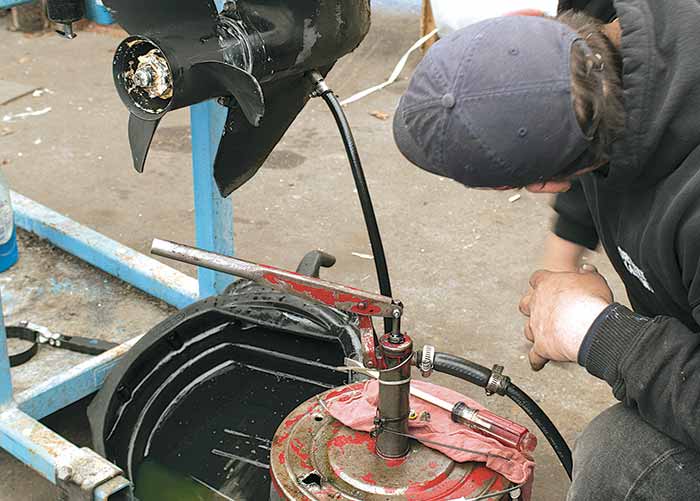Advertisement
Changing your lower-unit lube every fall is a necessity to eliminate any water and shavings before putting your boat to bed.

Changing the lower unit oil every year will go a long way to keeping your motor humming. (Photo: Mercury)
At least once a year, preferably when the season ends, you need to drag the drain pan out, buy some new lube, and spend half an hour draining and refilling the unit. Here's why: The lubricant's properties break down over time and with use, and its ability to keep the metal gears, bearings, and shafts operating without touching each other is diminished.
Second, the lube itself often becomes contaminated; tiny metal shavings (from normal gear wear) and moisture eventually reduce the lubricant's ability to reduce friction and prevent corrosion. Also, replacing the lube is a great way to get an up close and personal view of the guts of your engine's lower unit.
Do this at season's end because if water has entered the unit, you don't want it inside the gearcase while the unit is laid up all winter. As it rests, any water inside will stick to the gears, bearings, and shafts and cause corrosion. Once corrosion/rust watermarks appear on the bearing surfaces and the bearings themselves, it's only a matter of time before the unit fails during use.
If you drain water-contaminated lubricant out, even if you can't fix the cause (typically a failed prop-shaft seal) right away, you can at least fill the unit with fresh, clean lube and avoid the rust problem over the layup period. In addition, a serious case of water contamination can crack the gearcase if it's exposed to freezing conditions.
"Clean and healthy" gear lube, depending on the dye used in its formulation, is typically amber, blue, or red in color and clear. If it's contaminated by water, it appears milky and has a coffee-with-cream color.
The other obvious condition is burned lubricant; it is blackish in color and has a bad burnt smell. This indicates that inside there's either a wear problem or an improper gear setup problem.
Many gearcase drain screws have a built-in magnet that collects the metal shavings. When you drain the lube, a small amount of fine shavings on this magnet is normal. A large amount of heavy metal filings (larger than the eraser on a pencil) coupled with the burnt, blackish lube indicates a serious wear problem inside the case with damage occurring.
Whether clear, milky, or burnt, the old oil must be drained completely and replaced with new. Here's how.
Technical Support
Difficulty: Easy
Materials & Tools:- Gearcase oil (check manual for amount)
- O-rings
- Screwdriver
- Oil collection pan
- Gearcase lube pump (optional)
Time: 30 minutes
Cost: Approximately $20

1. After placing a suitable oil drain pan under the engine to catch the used oil for recycling (visit earth911.com to find a location), unscrew the drain and vent screws, and allow oil to run out. Ensure that your screwdriver is large enough to remove the drain and vent screws without slipping and potentially ruining the screw slot, which will make future removals and reinstalls tough.

2. When all the old oil has finished draining, it's time to add fresh lube. It sounds counterintuitive, but the new oil is forced in through the drain hole. Professionals use a heavy-duty pump for this task, but most DIYers can connect up the plastic tube that comes with the quart oil container, then squeeze the soft-sided oil container to force the oil into the gearcase.

3. Fill slowly; there's no rush. Notice the solid flow of lube coming out of the vent hole (see arrow); no air bubbles means it's truly full. Wipe up any drips with a clean rag before replacing the vent screw — don't forget to replace the washer.
Replacing the upper vent screw creates a small vacuum so that when you remove the filler and replace the lower drain screw, you won't lose much lubricant in the process.

4. Notice the expanded, distorted drain-screw gasket on the right; a new one is on the left. These gaskets are cheap; replace them each time you change the gear lube.
9 Tips For A Trouble-Free Lube Change
- Run the engine for a few minutes on a flusher to loosen up and warm the oil inside the gearcase, particularly if you're changing the lube when it's cold outside.
- Make sure the drain pan is large enough and positioned under the lower drain screw so lubricant won't splash onto the ground.
- Check your engine manual or with your dealer to ensure that you're using the correct lubricant for your engine. Using the incorrect lubricant could void your warranty.
- Consider investing in a lubricant reservoir and pump if you have more than one engine. These units make pumping new lube in much easier.
- Use new gaskets on the drain/fill and vent screws; even though you can get away with using the same ones a few times, it's better to change them out.
- Take your time when draining the unit to make sure that all the old lube drains out; also take your time refilling with the new lube, as air bubbles can form if you try to fill too quickly. This can be a problem because if an air bubble forms, it prohibits filling the unit all the way, and the upper driveshaft bearing will be starved for lubricant, making it liable to fail under load.
- It sounds counterintuitive, but the gearcase is filled by forcing oil into the lower hole. The gearcase is full when oil starts to come out of the top vent hole.
- While you're changing the lube, remove the prop and check for fishing-line snarls behind the thrust washer. Grease the prop shaft, then reinstall the prop when you're done.
- Dispose of the dirty oil at your recycling facility or at a marina set up to receive it.
